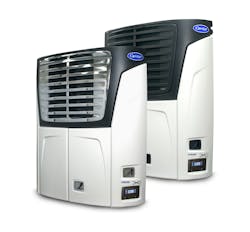Carrier Transicold unveils new X4 Series refrigeration units
Carrier Transicold has introduced its X4 Series of trailer refrigeration units. The ultra-high efficient units meet the new Tier 4 emissions requirements.
“Along with emissions compliance, the X4 Series offers the highest refrigeration capacities ever delivered by Carrier Transicold trailer units, combined with lower fuel consumption, lower maintenance costs, lighter weight and quieter operation than our prior platform,” said David Appel, president, Carrier Transicold.
The X4 Series includes the 7500 and 7300 single-temperature belt-driven models, which both require less power than Carrier Transicold’s prior platform as well as competitive equipment designed for 2013 Tier 4 compliance, the company said. Respectively, the new units provide 68,000 and 66,000 BTUs of cooling at a setpoint of 35 deg. F (100 F ambient).
“Our new X4 Series uses significantly less engine power, fuel and refrigerant while still achieving higher refrigeration capacities and faster pulldown than our previous models,” said Tom Ondo, general manager, Truck/Trailer Americas, Carrier Transicold. “The new units are so efficient that they achieve 35 to 50 percent more BTUs of cooling per gallon of fuel, at AHRI rating conditions, than our current designs, making them a smart decision for fleets looking to optimize the efficiency of their refrigerated assets.”
The units include Carrier’s ecoForward technologies that refine the design of unit components and equip the 2.2L engine with sensors and an electronic control module that communicates with Carrier’s APX control system for optimized performance.
Compared to the Carrier Transicold X2 series models they succeed – the 2100 and 2500 respectively – the new X4 units:
- Weigh 30 pounds less, which, at 230 pounds, makes them about 13% lighter than competitive models designed for 2013 EPA Tier 4 compliance;
- Provide 3 to 10% higher cooling capacity (depending on model);
- Achieve up to 20% faster pulldown;
- Consume 5 to 22% less fuel over a full range of operating conditions; and up to 35% less fuel during pulldown;
- Require 24% less refrigerant;
- Operate at up to 18% slower speeds and reduce engine runtime by up to 15%, resulting in improvements in durability and longevity as a result of more lightly loaded components.
According to Carrier, system improvements include high efficiency components, such as optimized V-Force fans and Novation micro-channel condenser coils. An electronic expansion valve is now standard, replacing mechanical expansion valves found on previous models and competitive units.
Fleets will have the ability to equip units with an optional engine emissions system, further reducing emissions to provide future compliance in California beyond the initial seven years.
